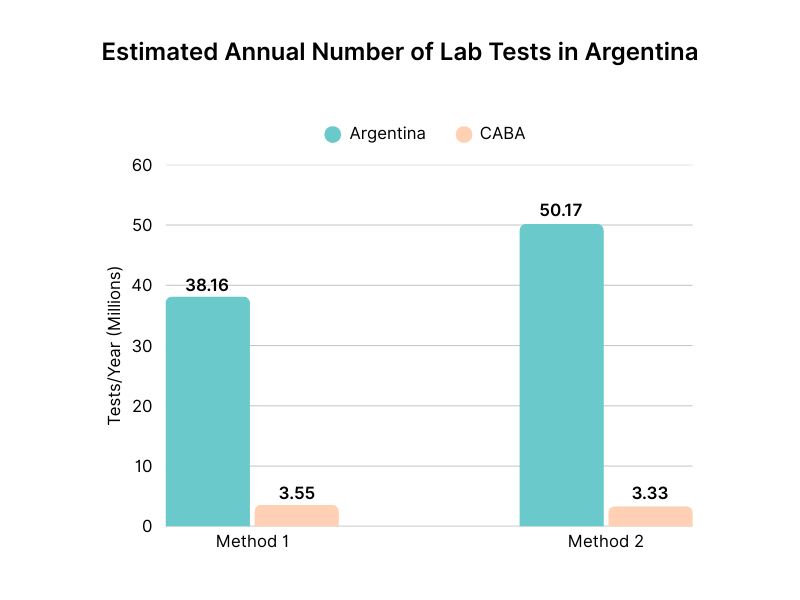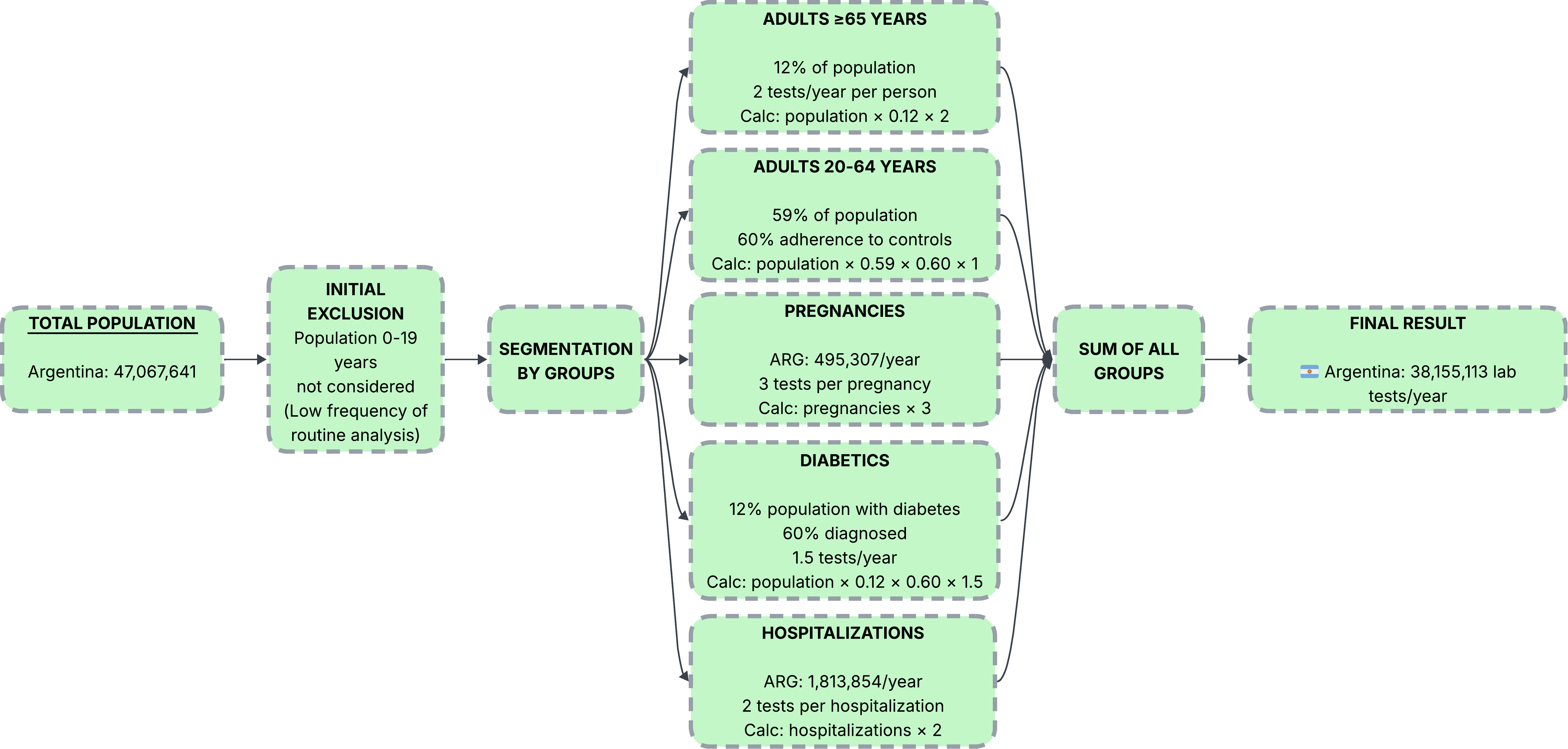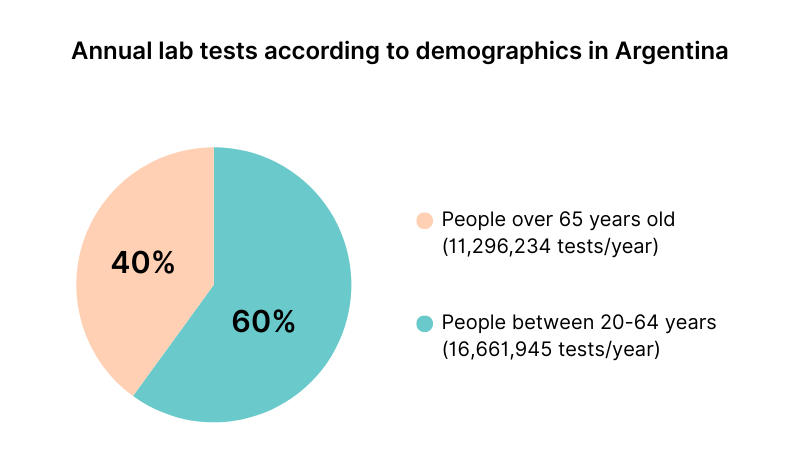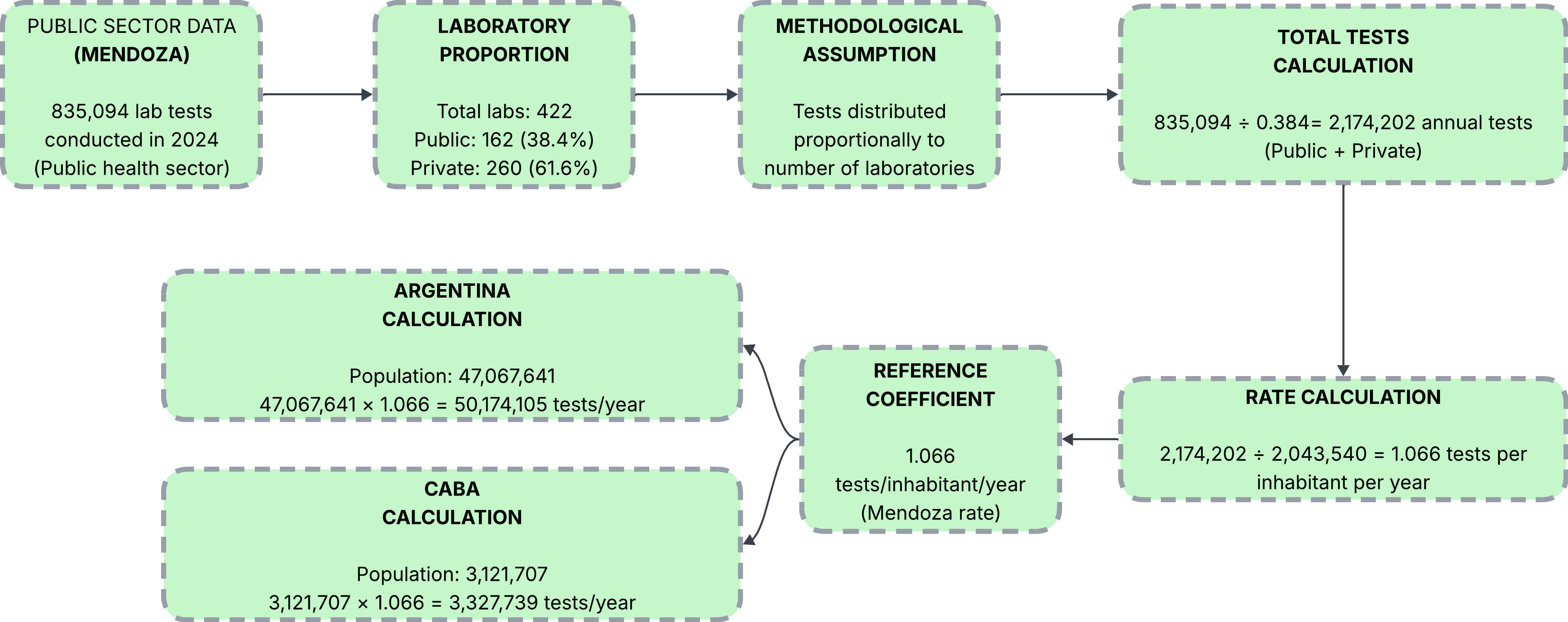Abstract
To answer the question, "How many people in Argentina undergo lab tests annually at diagnostic centers, across both public and private systems?", we carried out a thorough literature review complemented by detailed analyses, estimations, correlations, and extrapolations from diverse data sources.
Due to the absence of official, direct statistics on the total annual number of lab tests performed in Argentina and City of Buenos Aires – (CABA), we approached the estimate from two angles. Method 1 sums up populations that commonly receive tests, such as adults attending routine checkups, older adults, individuals monitoring diabetes, pregnant women, and those undergoing hospital-related testing. Method 2 leverages data from Mendoza to calculate a per-person testing rate, which is then scaled to reflect the national and CABA populations.
The findings are as follows:
- Method 1: Approximately 38 million tests per year in Argentina; 3.5 million tests per year in CABA.
- Method 2: Approximately 50 million tests per year in Argentina; 3.3 million tests per year in CABA.

Introduction
Clinical tests play a central role in modern healthcare, guiding diagnosis, treatment and disease prevention. They help screen for common risks, monitor chronic conditions like diabetes, guide treatment decisions during hospital care, and support checks during pregnancy. Many adults are advised to have periodic routine lab tests; older adults tend to test more often due to higher rates of chronic illness. During pregnancy, lab tests are standard across trimesters. And when people are hospitalized, basic labs are often taken on admission and again before discharge.
Since no single official total exists for lab tests, this article does two things. First, it adds up the main use cases (routine adult testing, older-adult care, diabetes monitoring, pregnancy, and hospitalization-related tests) to produce a country and CABA figure. Second, it cross-checks that result with a per-person rate derived from Mendoza, scaled to the national and CABA populations.
Methodology & Results
Method 1 - Estimation Based on Demographic Data and Health Recommendations

1. Demographics
Preventive medical recommendations for different age groups were considered in the analysis. The population aged 0–19 years was excluded, as routine lab tests are uncommon in this group except in cases of illness.
According to INDEC projections for July 2024, Argentina’s total population is estimated at 47,067,641 inhabitants[10]. Adults aged 20–64 years represent 59% of the total (27,769,908 people)[5][9]. It was assumed, based on international guidelines, that they should undergo one lab test annually. However, an adherence rate of 60% was applied, supported by indirect indicators such as the 40% of people with diabetes who are unaware of their condition[7], and the similar proportion of the population without health coverage[8], who rely solely on the public sector where preventive checkups are less accessible. This results in an estimated 16,661,945 tests/year.
Adults aged 65 years and over make up 12% of the population (5,648,117 people)[5][9]. Due to a higher burden of comorbidities, it was assumed that each person in this group undergoes an average of two tests per year[1][4], totaling 11,296,234 tests/year.

2. Diagnosed diabetics
A second key component in estimating the total number of annual lab tests was the analysis of chronic diseases, using diabetes as a reference. This condition was chosen because it requires regular laboratory monitoring and has relatively abundant demographic data and published studies[3][6][7].
In Argentina, around 12% of the population is estimated to have diabetes, but only about 60% are aware of their diagnosis[7]. For those diagnosed, clinical guidelines recommend at least one to two tests annually to monitor glucose, glycated hemoglobin (HbA1c), and lipid profile. For calculation purposes, a conservative average of 1.5 tests/year per diagnosed person was applied[1][4][7].
From this:
- Total population with diabetes (12%): 5,648,117 people.
- Diagnosed cases (60%): 3,388,870 people.
- Tests/year: 3,388,870 × 1.5 = 5,083,305 tests annually.
This analysis also supports the earlier assumption that only around 60% of the general population adheres to annual preventive checkups, as approximately 40% of people with type 2 diabetes remain undiagnosed[7]. This low diagnosis rate suggests similar patterns of underutilization of preventive lab testing in the broader population, influenced by healthcare access.
3. Annual pregnancies
Pregnancies were also included in the estimate, as they involve routine laboratory checkups throughout gestation. Based on the average of the last three recorded years (2021–2023), Argentina registers approximately 495,307 pregnancies per year[2].
Clinical guidelines recommend at least one test per trimester, resulting in three tests per pregnancy[1][4].
- Annual pregnancies: 495,307
- Tests per pregnancy: 3
- Estimated total: 495,307 × 3 = 1,485,921 tests/year
4. Hospitalizations for acute or chronic diseases
Hospitalizations were also considered, as many acute and chronic conditions require lab tests for diagnosis and follow-up. Using data from the Ministry of Health’s Interactive Health Statistics Report, the average number of hospital admissions over the last three available years (2020–2022) was 2,179,753 per year[2].
After excluding pathologies that do not typically require lab tests, the filtered annual average was 1,813,854 hospitalizations[2]. For calculation purposes, it was conservatively assumed that each patient undergoes at least two tests (one upon admission and one at discharge) though in practice this number is often higher depending on clinical complexity.
- Annual hospitalizations requiring tests: 1,813,854
- Tests per hospitalization: 2
- Estimated total: 1,813,854 × 2 = 3,627,708 tests/year
Summary
| Category | Estimated Annual Tests (Argentina) |
|---|---|
| Aged 65 and over | 11,296,234 |
| Adults aged 20–64 | 16,661,945 |
| Diagnosed diabetics | 5,083,305 |
| Pregnant individuals | 1,485,921 |
| Hospitalizations | 3,627,708 |
| TOTAL | 38,155,113 |
| Category | Estimated Annual Tests (CABA) |
|---|---|
| Aged 65 and over | 1,469,208 |
| Adults aged 20–64 | 1,105,084 |
| Diagnosed diabetics | 661,143 |
| Pregnant individuals | 74,721 |
| Hospitalizations | 243,492 |
| TOTAL | 3,553,648 |
Method 2 - Estimation of Lab Tests in Argentina and CABA using Mendoza as a reference
Another method used to estimate the number of lab tests performed annually in Argentina and in the Autonomous City of Buenos Aires (CABA) used Mendoza province as a reference, as it is an intermediate jurisdiction with a mixed health system and availability of updated data.

According to recent data, Mendoza has an approximate population of 2,043,540 inhabitants[5][9]. In the public health sector, 835,094 tests were conducted during 2024[11]. To estimate the total number of tests (including both public and private sectors), the proportion of available laboratories was used: 422 total, 162 are public and 260 are private[12]. This represents 38.4% public laboratories and 61.6% private laboratories.
Since no specific test count is available by sector, it was methodologically assumed that tests are distributed proportionally to the number of laboratories. This is a reasonable assumption for an initial estimate. Under this assumption, if 38.4% of the laboratories (public) perform 835,094 tests, the estimated total number of tests in Mendoza would be:
- 835,094 / 0.384 = 2,174,202 annual tests (public + private)
With this data, the rate of tests per inhabitant in Mendoza can be calculated:
- 2,174,202 / 2,043,540 = 1.066 tests per inhabitant per year
This value serves as a reference coefficient to extrapolate to the rest of the country. According to INDEC projections for July 2024, Argentina's total population is approximately 47,067,641 people[10]. Applying Mendoza's rate to this population:
- 47,067,641 x 1.066 = 50,174,105 estimated annual tests in Argentina
In the case of CABA, with a population of 3,121,707 inhabitants:
- 3,121,707 x 1.066 = 3,327,739 estimated annual tests in CABA
Summary of Estimates
| Region | Population | Estimated Annual Tests |
|---|---|---|
| Mendoza | 2,043,540 | 2,174,200 |
| CABA | 3,121,707 | 3,327,739 |
| Argentina | 47,067,641 | 50,174,105 |
Conclusion
Taken together, the two methods suggest that Argentina performs tens of millions of lab tests each year, with the Autonomous City of Buenos Aires (CABA) representing a substantial proportion:
- Method 1: 38,155,113 tests/year (Argentina); 3,553,648 (CABA).
- Method 2: 50,174,105 tests/year (Argentina); 3,327,739 (CABA).
A few points should be kept in mind regarding Method 1, which combines data from major, well-defined population groups with known testing requirements (such as older adults, pregnant individuals, diabetics, and hospitalized patients). While this approach provides a structured and data-driven estimate, it has limitations. Some individuals may belong to more than one group, for example an older adult who is also hospitalized or a pregnant woman with diabetes potentially leading to double counting and overstating the total. At the same time, the calculation excludes several testing scenarios, such as those involving healthy people under 20 years old or tests performed for preoperative, occupational, hormonal, fertility, and other purposes, which may lead to underestimation. For these reasons, the result should be viewed as an approximation rather than a definitive figure.
On the other hand, Method 2 takes a different approach, using Mendoza province as a reference point. With its mixed public–private health system and updated laboratory data, Mendoza provides a per-person testing rate that can be extrapolated to the entire country and to CABA. The calculation assumes that the distribution of tests between public and private laboratories in Mendoza reflects the national pattern and that this relationship remains consistent across provinces. In reality, factors such as regional variations in healthcare access, disease prevalence, and the balance between public and private providers could lead to differences in the actual numbers. Nevertheless, this method offers a useful independent benchmark for comparison with the results from Method 1.
Taken together, these methods provide a practical decision range rather than a single, exact value. For purposes such as planning service capacity, determining resource allocation, or assessing market potential, the space between Method 1 and Method 2 offers a solid and evidence-based starting point. As more unified and comprehensive national reporting becomes available, these estimates can be refined to produce more precise figures.
References
- Infobae. (2023, marzo 2). Chequeos médicos: cuándo hay que hacerlos, con qué frecuencia y qué incluyen. https://www.infobae.com/salud/2023/03/02/chequeos-medicos-cuando-hay-que-hacerlos-con-que-frecuencia-y-que-incluyen/
- Ministerio de Salud de la Nación. (s. f.-a). Reporte interactivo de estadísticas en salud. https://www.argentina.gob.ar/salud/deis/reporte-interactivo
- Ministerio de Salud de la Nación & Instituto Nacional de Estadística y Censos (INDEC). (2019). 4ta Encuesta Nacional de Factores de Riesgo: Principales resultados. PDF
- MedlinePlus. (s. f.). Chequeos médicos regulares (también llamados exámenes físicos de rutina). Biblioteca Nacional de Medicina de EE. UU. https://medlineplus.gov/spanish/healthcheckup.html
- Instituto Nacional de Estadística y Censos (INDEC). (s. f.-a). Indicadores demográficos. INDEC. https://www.indec.gob.ar/indec/web/Institucional-Indec-IndicadoresDemograficos
- Fundación Argentina Diabetes (FAD). (2023, mayo). Nuestra Voz, (83). PDF
- Ministerio de Salud de la Nación. (s. f.-b). Glosario – Diabetes. https://www.argentina.gob.ar/salud/glosario/diabetes
- Instituto Nacional de Estadística y Censos (INDEC). (s. f.-b). Población con cobertura de salud. https://censo.gob.ar/index.php/el-609-de-la-poblacion-tiene-obra-social-prepaga-o-cobertura-de-pami/
- Instituto Nacional de Estadística y Censos (INDEC). (s. f.-c). Datos definitivos – Ciudad Autónoma de Buenos Aires. https://censo.gob.ar/index.php/datos_definitivos_caba/
- Instituto Nacional de Estadística y Censos (INDEC). (s. f.-d). Proyecciones y estimaciones. INDEC.
- Gobierno de Mendoza. (s. f.). Prestaciones de laboratorio - SISAP. Ministerio de Salud de Mendoza. https://infosalud.mendoza.gov.ar/sisap/…
- Asociación de Bioquímica de Mendoza (ABM). (s. f.). Buscador de laboratorios. https://socios.abm.org.ar/appx_pub/panel/buscador_labs
